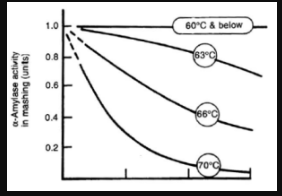The trouble with mashing in at 155 F then letting the temperature fall to promote beta amylase is that the beta is essentially all gone in the first 10 minutes at 155 F.
I suppose if one is starting with a low diastatic power mash, it might be fair to say that the beta amylase is essentially gone, in practical terms, at 10 minutes at 155F.
At any given temperature, amylase enzymes denature in a half-life fashion, like so many physical processes. Of course, how much diastatic power (in degrees lintner) survives after "X" minutes depends very much on how much you start with. e.g. a Pilsner Malt mash will have a lot more power relative to a Maris Otter mash, for any given amount of time passed.
I have derived approximate formulae for alpha and beta denaturing, based on (other peoples') research data and a discussion (about interpretation of the data) in another forum. The Beta estimate looks like this (in excel format):
=9460*EXP(-0.098*((A1-32)*5/9))
...where the A1 cell is the temperature in degrees F. At 155F, this formula yields a half-life of ~11.7 minutes. So at 10 minutes, by this estimate over half of the Beta Amylase would still be around. At 23.4 minutes about 25% of the Beta Amylase would survive.
Formulae aside, the point I want to make is that amylase enzyme denaturing happens in a half-life fashion and that the amount of beginning DP has a very direct bearing on how much enzyme will still be around at a given time in the mash.


























![Craft A Brew - Safale S-04 Dry Yeast - Fermentis - English Ale Dry Yeast - For English and American Ales and Hard Apple Ciders - Ingredients for Home Brewing - Beer Making Supplies - [1 Pack]](https://m.media-amazon.com/images/I/41fVGNh6JfL._SL500_.jpg)

































